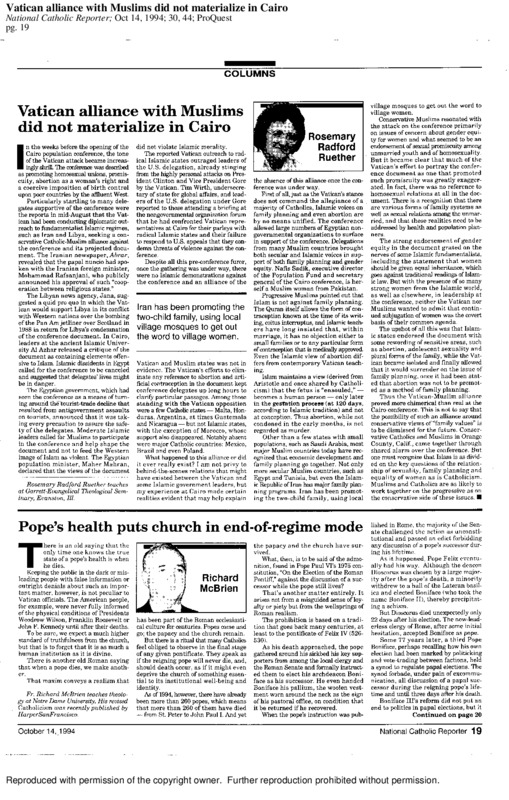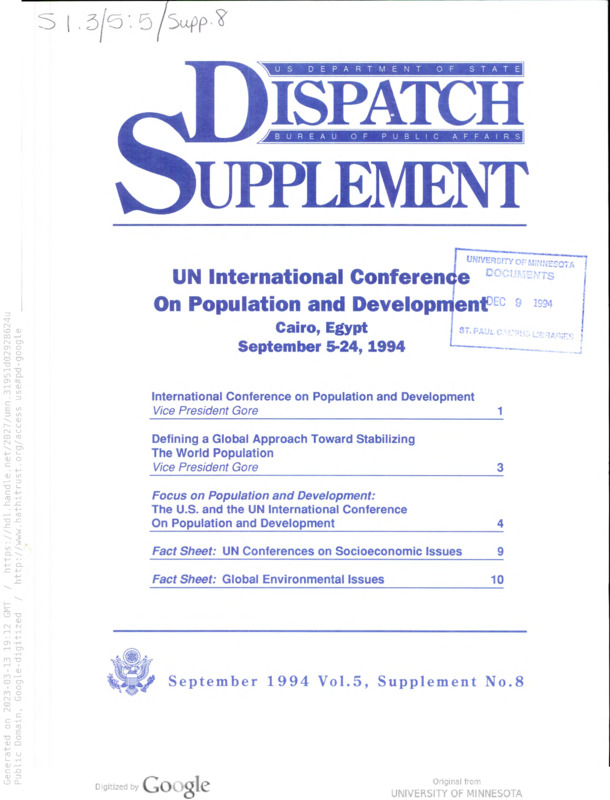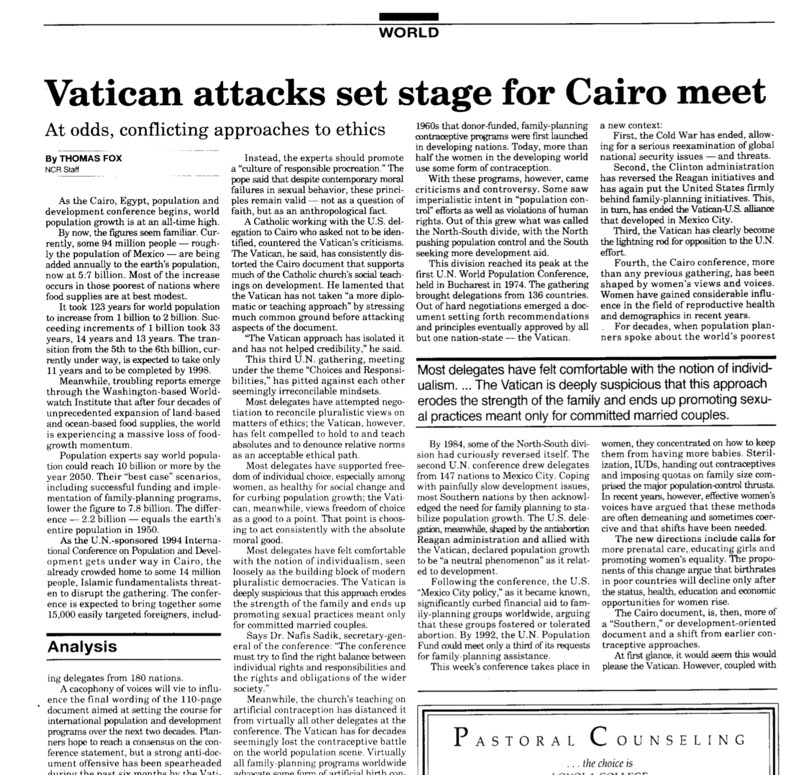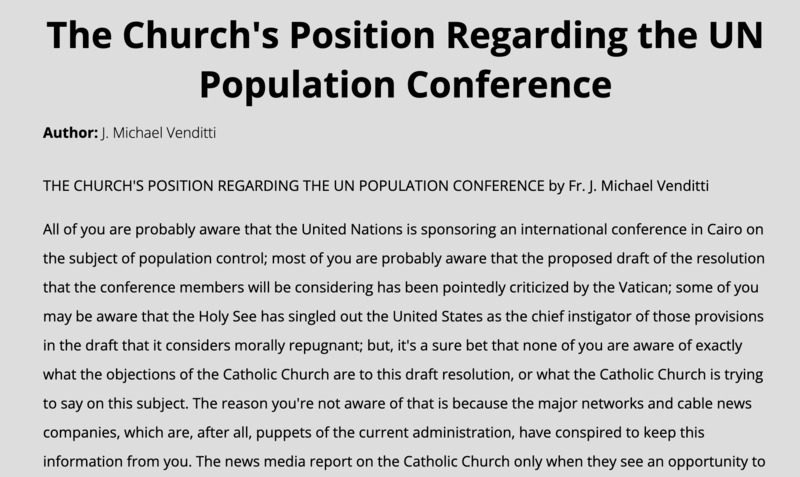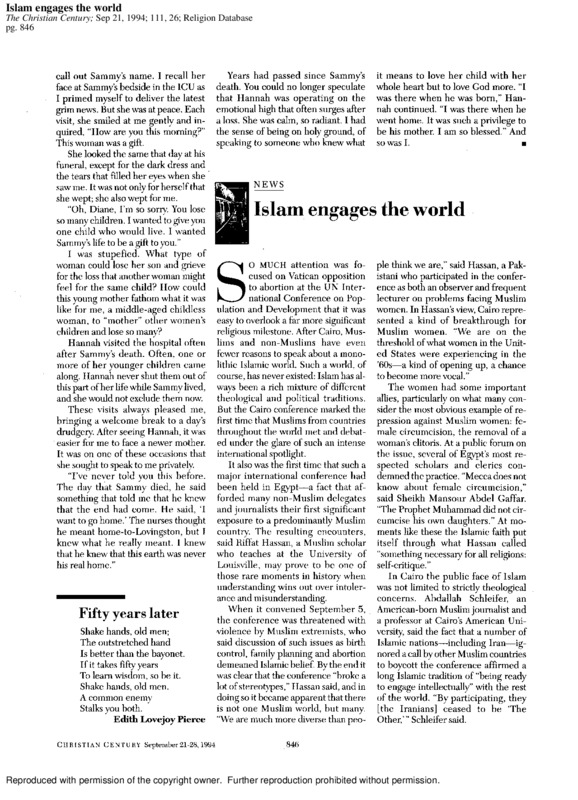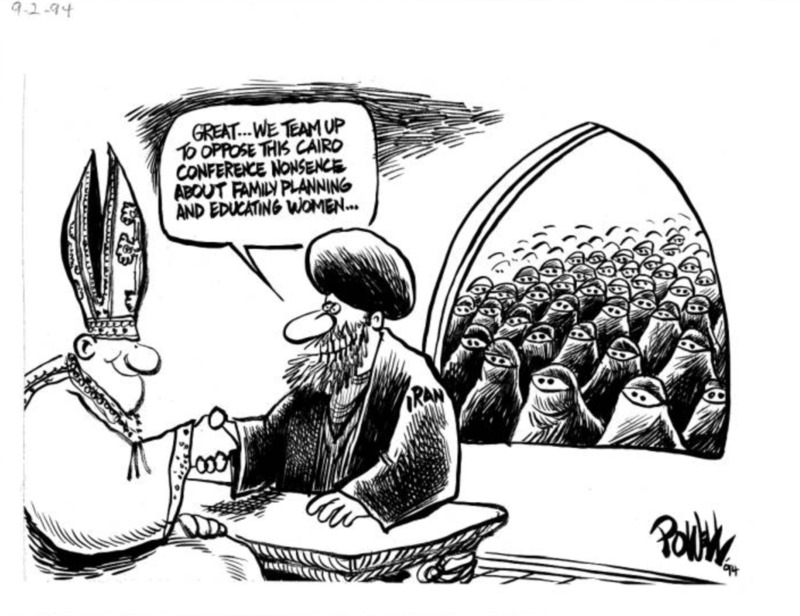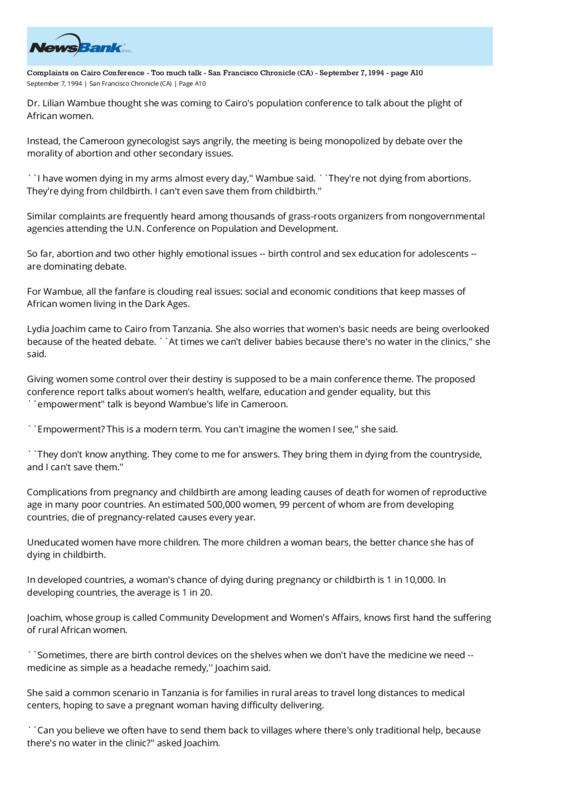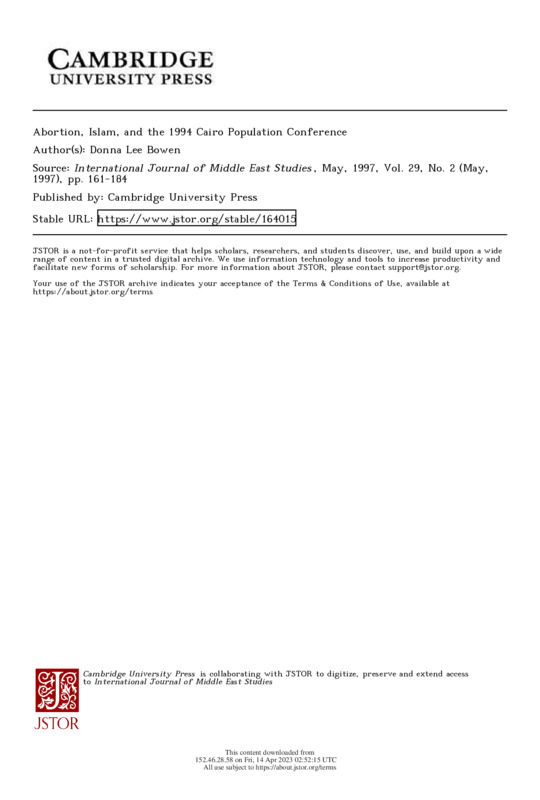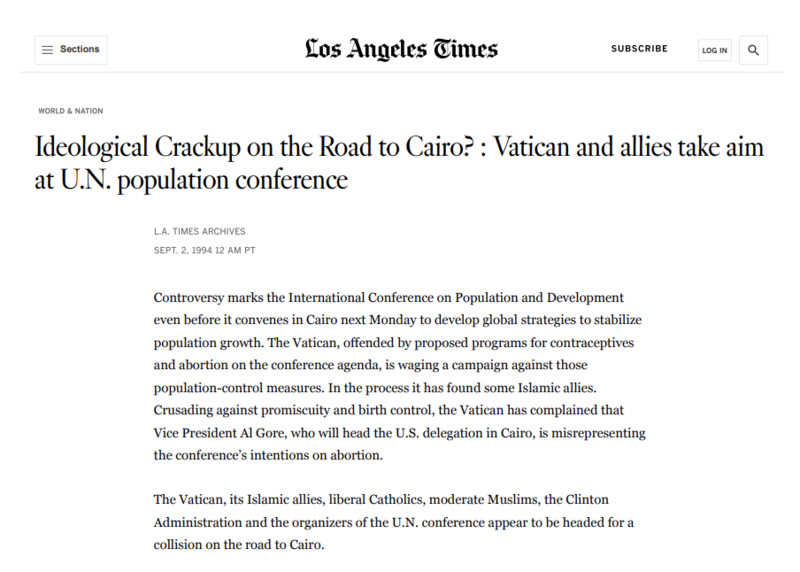Reactions in the United States
Below is a list of primary sources from the United States reflecting upon or reacting to the 1994 Population Conference in Cairo, Egypt.
In "Vatican Alliance with Muslims did not Materialize in Cairo" from The National Catholic Reporter (Kansas City, Missouri), Rosemary Radford Ruether, a feminist theologian, discusses the factors which hindered a complete and cohesive ideological alliance between the Vatican and Islamic powers. Despite Vatican outreach to Islamic states and a perceived agreement on controversial conference topics (i.e., birth control and abortion), Ruether argues an alliance did not occur as neither party (the Vatican, and its Catholic followers, and Muslim States) had a unified stance on abortion and family planning. Moreover, as Ruether suggests, progressice Muslims did not agree with the strict view that abortion equates to murder as the Vaticans advocated for. However, one thing the parties did agree on was their concern over gender equality for women and what they argued was a "endorsement of sexual promiscuity." Although, with a strong female presence at the conference, Ruther concludes, neither the Vatican or Muslims "wanted to admit that continued subjugation of women was the covert basis of their common agenda." While some conservative Catholics and Muslims may object to the conversations of sexuality at the Cairo Population Conference, Ruether suggests the real simialrity of these two religious bodies is their in-party division and inability to unite on questions surrounding "relationship of sexuality, family planning, and equality for women."
This article summarizes and quotes from Al Gore’s remarks at the Cairo conference as the Vice President of the United States. These remarks were given at the opening session of the conference to establish the U.S. concerns and positions approaching the conference, including the U.S. stance on abortion. Gore states: “I want to be clear about the U.S. position on abortion so that there is no misunderstanding. We believe that making available the highest quality family planning and health care services will, simultaneously, respect women's own desires to prevent unintended pregnancies, and reduce population growth and the rate of abortion.” This position, in the context of a post-Roe U.S. in the mid-90s, was controversial but not surprising to Americans, but for anti-abortion delegates and groups at the conference, this stance was protested and argued against, especially in the lead-up to the conference, as can be seen in other sources on this page. However, Gore goes on to say that the U.S. “does not seek to establish a new international right to abortion, and [they] do not believe that abortion should be encouraged as a method of family planning,” a stance that is echoed in the conference statement on abortion included on the introductory page to this exhibit.
The National Catholic Reporter, a newspaper based in Kansas City, Missouri, published this article entitled "Vatican Attacks Set Stage for Cairo Meet" in the middle of the conference on September 9, 1994. The article opens with the imminent fears of overpopulation, claiming that some statistics reports predict the global population to be around 10 billion by 2050. Additionally, pressing issues of declining food production, at least in terms of the rapid population growth, were also stated in the introduction of the article. The article's overall claim is to combat population control by promoting a "'culture of responsible procreation.'" Although the Pope claims that the contemporary moral failures of current society regarding "sexual behavior" are a concrete reason for the population crisis, the urgency of the issue should not combatted from a perspective of "faith, but as an anthropological fact." Intertwining religious rhetoric with interdisciplinary expertise, reporter Thomas Fox introduces source Dr. Nafis Sedik, security-general of the conference, who is quoted in the article: "The conference must try to find the right balance between individual rights and responsibilities and the rights and obligations of wider society."
Yet, whereas the article states that most delegates "felt comfortable with the notion of individualism," the headliner states that the Vatican remains "deeply suspicious that this approach erodes the strength of the family and ends up promoting sexual practices meant only for committed married couples." Thus, the conference proved to be conducted in stark opposition towards Vatican ideology, resulting in the ending of the US-Vatican alliance that developed in Mexico City due to American support for family-planning initiatives. The article represents the role religion still plays within the poltiical realm, and how states interact under their prioritization of perceived religious or legal law.
Father J. Michael Venditti of Byzantine Catholic Eparchy of Passaic, New Jersey, a diocese of the Byzantine Catholic Metropolitan Church, speaks on the Catholic Church’s position in regards to the U.N. Population Conference in Cairo, Egypt. To begin, Father Venditti criticizes the media by claiming that it tends to boil down the true story. To illustrate, he says, “rather than give a complete and nuanced presentation of Catholic teaching, they simply inform us that the Church is causing trouble at the conference because of its rigid stance on contraception and abortion…”
Father Venditti sets a goal of informing his audience of the truth. While doing so, he hopes to correct “the lies told to you on television, and defend the teaching of the Church.” Additionally, he recognizes how population control is not a new concept in the world. In fact, Father J. Michael Venditti claims that population control is “nothing more than a cheaper alternative to charity.” Finally, Father Venditti ends with praying that the truth about the sanctity of life will be heard in Cairo, Egypt at the Cairo Conference.
From Chicago’s The Christian Century, “Islam Engages the World” discusses the ways in which the 1994 Cairo Population Conference “marked the first time that Muslims from countries throughout the world met and debated under the glare of such an intense and international spotlight.” When the conference convened on September 5th, Muslim extremists threatened the conference with violence who argued conversations surrounding birth control, family planning, and abortion “demeaned Islamic belief.” Many Muslim leaders joined the Vatican’s dissent of the conference's preconceived support of abortion as birth control and that the secular Western gathering would “weaken the family and undercut sexual ethics.” However, the Cairo conference also “exemplified Islamic traditions of tolerance, diversity of opinions, intellectualism,” which did not align with the Muslim conservatives or extremists. Ultimately, as suggested by one U.S. delegate, “the Islamic position on abortion proved more nuanced than the Vatican’s.”
Dwane Powell, a cartoonist for the News & Observer in Raleigh, North Carolina, depicts an agreement being made between a pope-like figure, as representative of the Vatican, and a caricature for the Islamic faith, specifically highlighting “Iran” on their shoulder. Outside, numerous stereotypically presented Muslim women look in from the window. The bubbled text addresses the Cairo Conference directly: “Great… we team up to oppose this Cairo Conference about family planning and educating women…”
This cartoon was published on September 2nd, about three days before the conference began and is thus based on predictions of the Conference.
The depiction of the Vatican-Muslim alliance references the assumption that Muslims would support the Vatican strictness on abortion, birth control, and female equality. Despite the depicted agreement between the Vatican and Iran, this alliance did not form because of the lack of unification in belief within each religious party. Ironically, although Powell chooses to reference Iran, Iran's position on these issues proved much more nuanced than the Vatican’s and ultimately had no conclusive or united agreement with Vatican beliefs. Although conservative and extremist Muslims and Catholics did similarly contend with issues of the conference, other voices within these religious groups had differing opinions which prevented the alliance previously expected.
In the window, as mentioned before, is a crowd of Muslim women looking into the discussion between the Vatican and Muslim faiths. This is likely done to show that despite the discussion of the conference including implications for Muslim women, Muslim women (especially within an extremist ideological setting) were not given (or given very little) voice. However, it is interesting to note that the Vatican also lacked equal female commentary and opinion and both groups lacked a strong female influence.
From the San Francisco Chronicle, “Complaints on Cairo Conference / Too Much Talk About Abortion African Women Say” African women discuss the lack of conversation around reproductive healthcare in developing countries. Although women’s health, welfare, education, and gender equality were some of the top concerns of the conference, these women argue that this “empowerment” framework fails to recognize the basic needs which are being unmet for women in developing countries. Joachim, a member of Community Development and Women’s Affairs, is at the forefront of the suffering which goes unaddressed with rural African women: “‘Sometimes, there are birth control devices on the shelves when we don’t have the medicine we need– medicine as simple as a headache remedy.” Despite the media's emphasis on birth control and abortion debates among religious and political groups, these women highlight the leading cause of death for women in developing countries, complications from pregnancy and childbirth, ultimately went unaddressed at the Cairo Population Conference.
“Abortion, Islam, and the 1994 Cairo Population Conference,” written by Donna Lee Bown, a Professor of Political Science and Middle East Studies at Brigham Young University, details the division of opinion on abortion within schools of Islamic faith and law shown through the 1994 Cairo Population Conference. Bowen begins with the spurred alliance between Muslim nations and the Vatican based on the common prohibition of abortion. However, as Bowen points out, the Muslim delegations ultimately differed from the Vatican condemnation of abortion, and thus reveals Muslim unification on the issue has not been reached.
While the issue of abortion originally represented to Muslims an attack on their core religious principles and values (i.e., the traditional family), “as the conference continued… it became evident that there was a greater degree of latitude in the Muslim religious position than was originally represented by articles in the press and statements by ultraconservative Muslim groups that linked the Muslim and Vatican positions.” Bowen suggests that Muslim position on abortion ranges from a complete permission for abortion in the first 120 days to total prohibition, and although undesirable, cannot be totally forbidden in certain cases (i.e., mother’s life).
“The differences between the Vatican position and that of the Muslim states emerged clearly by the end of the conference. Although the majority of the Muslim states agreed with the Vatican that abortion should not be deemed a method of family planning, and that sexual activity should be confined to marriage, unliked the Vatican they supported the use of contraceptives for family planning, the use of condoms for protection from sexually transmitted diseases, and the use of abortion in well-defined situations.”
From this, Bowen concludes that “The nuances of the Islamic legal position on abortion indicate that the academic, legal, and religious discussion of [abortion] is more sophisticated than was evidenced by the stands generated at the outset of the Cairo conference.”
This article from the Los Angeles Times discusses the controversy regarding the International Conference on Population and Development prior to its start. First, it describes the Vatican’s reaction and its disagreement with the “proposed programs for contraceptives and abortion on the conference agenda.” Additionally, the article includes the Vatican’s complaints that Vice President Al Gore is “misrepresenting the conference’s intentions on abortion.” The Los Angeles Times even predicts that the “Vatican, its Islamic allies, liberal Catholics, moderate Muslims, the Clinton Administration and the organizers of the U.N. conference appear to be headed for a collision on the road to Cairo.”
Furthermore, the Los Angeles Times addresses the big picture. The article claims that the population conference is not about denigrating family, church or religion. Additionally, the article recognizes how it is not about coercive programs or abortions. Rather, the conference’s draft plan centers on improving both the social and economic status of women. Finally, the plan advocates for the “explicitly advocates the right of women to safe, effective, affordable and acceptable methods of fertility regulation of their choice.” This includes “pregnancy termination” as part of women’s reproductive health services.
